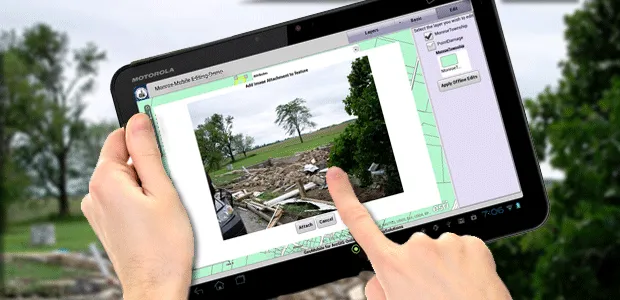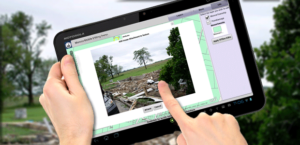Along with projection choice and scale options, design and colors have a huge impact on how well, and to who, the map will carry the appropriate message. As for all the mapping elements, the way the cartographer chooses to present the data (design, colors) tells a lot about his very interpretation of the mapped phenomena. What are the options offered to the cartographer in terms of design and color to build a good map? Let’s review some basics about design options, data set, colors conventions and then have a look at a map gallery from the media to reveal their hidden meanings.
Design options
The classical two dimensions “flat map” does not offer a lot of options. All maps are made of (at least one of those) three things:
You can make color or size of each geographical element vary according to the value attributed to it. That leaves basically six possible variations to play with: making the size and the color varies for lines, points or/and areas.
It is recommended not to use the six variations on one map, as it can get very confusing visually. The human eye will easily “gets” one simple map in less than 5 seconds, by browsing the screen making one zigzag from the top left corner to the bottom right, but will get confused by too many variations of size and colors.
There is an infinity of possibilities just by playing with those six variations, and new ones are invented every days. The map below, for instance, is technically a map made of points, but values are represented by peaks matching the population number of each world city. Like James says, “it is a new perspective on very well-known data”.
Data Set
Each data set has to be about comparable units. In other words, you can’t compare population of countries (one geographical entity) with population of cities (one other geographical entity) on the same map. It is usually recommended to keep things simple, especially if the map is at the global or continental scale: one map to compare countries, one other map to compare cities, and a nice infographic to put the two (or more) maps side by side and give a sense of scale.
One data set can include one, two, sometimes three or four parameters, but rarely more. On one “flat map”, it is pretty hard to superimpose clearly more than two or three information by geographical unit, especially if you are working at a regional or local scale and if you have a very dense and tight grid. Again, selecting data accurately is the key: maps are synthesis, just like infographics. There is no room for raw data, and certainly not for exhaustive catalogues.
Here is a good example of one very powerful map. There are three parameters behind it: average family income, average children income, and the variation rate between the two which is the only represented on the map.
Color conventions
Traditionally, cartographers use color gradations to illustrate how one parameter vary over a range (from a minimum to a maximum), the lighter color matching lowest values and getting gradually darker as the value increases. That can go the other way around, depending on the parameter.
Most people associate dark colors with negative things (areas where the problem is more serious will appear darker), which explains why we always see Africa looking dark red or dark brown on most world maps. Again, there is no rule engraved in the stone, as it can be a smart thing to deliberately revert conventions to emphasis one point, as long as it is made consciously.
Colors can also be used as a way of differentiating geographical units without implying a gradation (no value is better or worse than any other one), which is often the case of maps presenting qualitative data, like the one below about “who reads what and where” in the UK from the Guardian. However, colors have meanings that can vary according to cultures and times. It is important to keep in mind that coloring is never neutral.

THE MAP GALLERY
Example 1: The USA drought disaster in 2012
- Design: only areas are represented here, and only color varies
- Data Set: the geographical unit here is not clear – we can guess counties – but it does not really matter as what we want is a general sense of where (regionally) the drought is the most serious, at the scale of the United States
- Colors: a classic color gradation with a warm color, the darker areas matching with the lowest values, which makes sense considering that we are talking about a disaster and that the parameter here should be rain fall.
- Score: 8/10 – no mistake, good readability, clear and simple. There is however no mention of what values match what the cartographer decided to call “dry”, “moderate”, “severe”, “extreme” and “exceptional”, nor of what the parameter is.
Example 2: The World Urban Population (WWF, via Business Insider)

- Design: this one makes points size and color vary
- Data Set: that is a perfect example of a map mixing two data sets together: one geographical unit is the country (the purple, orange and light pink points), the other geographical unit is cities (dark pink points). On top of that, the country data set gives absolute numbers as well as percentages (millions of people and urban rate), although the city data set is only about absolute numbers (millions of people).
- Colors: There is no color gradation here. It seems like the cartographer picked up colors that look pretty, but they are not matching with the statistical lines given in the key. As cities are illustrating a different data set here, they should have been in a total different neutral color, such as grey or black, to separate them more clearly.
- Score: 3/10 – Terrible mix of variations. Check out the article from Business Insider this map was illustrating: there is no mention on that map of the small cities the article is about. Plus, if the point of the map was to show urban rate in the world, a color gradation of countries + size varying points to show important cities would have done the job more accurately with a better readability.
Example 3: Fire Engine Callouts around London, UK

- Design: Color and length of lines vary
- Data Set: There is no real geographical unit on this map, as points are fire stations and all exact locations of buildings firemen were called from. So we have the number of callouts (that matches the number of lines), types of callouts (showed by line colors) and distances between each fire station and the callouts.
- Colors: They are representing qualitative data here, so there was no gradation needed between the tones, which allowed to pick up a pretty set of matching colors here. The multiple use of purple for multiple causes of fire is, however, a bit confusing.
- Score: 9/10 – the clever use of colors to show the callouts reason allows a good readability on a map that, on top of being pretty, gives a complete and detailed overview of the topic.

 Earthquakes take thousands of lives in China every year. One of the biggest in recent history was in 2008 when as many as 90,000 people were killed during an earthquake that struck the Sichuan province. In addition, millions more were left homeless.
Earthquakes take thousands of lives in China every year. One of the biggest in recent history was in 2008 when as many as 90,000 people were killed during an earthquake that struck the Sichuan province. In addition, millions more were left homeless.










